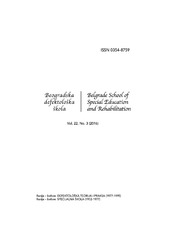Приказ основних података о документу
Cerebralna paraliza – šta nam literatura govori o složenosti ovog stanja?
Cerebral palsy – what does the literature tell us about the Complexity of this condition?
| dc.creator | Milićević, Milena | |
| dc.date.accessioned | 2021-10-22T07:46:52Z | |
| dc.date.available | 2021-10-22T07:46:52Z | |
| dc.date.issued | 2016 | |
| dc.identifier.issn | 0354-8759 | |
| dc.identifier.uri | http://rfasper.fasper.bg.ac.rs/handle/123456789/3637 | |
| dc.description.abstract | Rad je osmišljen s ciljem da se izdvoje i prikažu novija istraživanja fenomenologije cerebralne paralize i da se skrene pažnja stručne i naučne javnosti na neophodnost i značaj formiranja nacionalnog registra. Poseban naglasak je na izmenama definicije cerebralne paralize tokom prethodnih decenija, na različitosti postojećih klasifikacija i na varijabilnosti podataka o prevalenci cerebralne paralize i pridruženih stanja i poremećaja. Prikazano je i upoređeno šest najčešće korišćenih definicija i predstavljene tri klasifikacije (konvencionalna, fiziološka i Evropska klasifikacija cerebralne paralize). Uporedo su prikazani podaci o učestalosti s osvrtom na nalaze dostupnih nacionalnih istraživanja. Prikazom najčešćih pridruženih poremećaja je istaknuta heterogenost pojavnih stanja cerebralne paralize i ukazano na visoku zastupljenost višestruke ometenosti u ovoj populaciji. Umesto zaključka, upućen je svojevrsni apel za iniciranje formiranja nacionalnog registra i sagledavanje mogućnosti sistematskog organizovanja usluga i podrška na nivou populacije osoba s cerebralnom paralizom i njihovih porodica. | sr |
| dc.description.abstract | The paper was designed with the aim to select and present the recent research on phenomenology of cerebral palsy and to draw the attention of the professional and scientific public to the necessity and importance of establishing a national registry. Special emphasis was on changes to the cerebral palsy definition over the past decades, on the diversity of existing classifications and on the variability in the data on the prevalence of cerebral palsy and associated conditions and disorders. The six most commonly used definitions were introduced and compared, as well as three classifications (conventional, physiological and European classification of cerebral palsy). Data on the frequency were presented along with an overview of the findings of national surveys available. By presenting the most common associated disorders, the heterogeneity of manifestations of the conditions in cerebral palsy was emphasized. The high prevalence of multiple disabilities in this population was acknowledged. Instead of a conclusion, a kind of an appeal for initiating the formation of the national registry and considering possibilities of systematic organization of service and support at the level of the population of persons with cerebral palsy and their families was addressed. | sr |
| dc.language.iso | sr | sr |
| dc.publisher | Drustvo defektologa Srbije | sr |
| dc.publisher | Univerzitet u Beogradu – Fakultet za specijalnu edukaciju i rehabilitaciju (ICF) | sr |
| dc.relation | info:eu-repo/grantAgreement/MESTD/Integrated and Interdisciplinary Research (IIR or III)/47011/RS// | sr |
| dc.rights | openAccess | sr |
| dc.rights.uri | https://creativecommons.org/licenses/by-sa/4.0/ | |
| dc.source | Beogradska defektološka škola | sr |
| dc.subject | motorički poremećaj | sr |
| dc.subject | nacionalni registar | sr |
| dc.subject | planiranje usluga | sr |
| dc.subject | višestruka ometenost | sr |
| dc.subject | motor disorder | sr |
| dc.subject | national registry | sr |
| dc.subject | service planning | sr |
| dc.subject | multiple disabilities | sr |
| dc.title | Cerebralna paraliza – šta nam literatura govori o složenosti ovog stanja? | sr |
| dc.title | Cerebral palsy – what does the literature tell us about the Complexity of this condition? | sr |
| dc.type | article | sr |
| dc.rights.license | BY-SA | sr |
| dc.citation.issue | 3 | |
| dc.citation.rank | M52 | |
| dc.citation.spage | 53 | |
| dc.citation.volume | 22 | |
| dc.citation.volume | 71 | |
| dc.identifier.fulltext | http://rfasper.fasper.bg.ac.rs/bitstream/id/3891/milicevic.pdf | |
| dc.identifier.rcub | https://hdl.handle.net/21.15107/rcub_rfasper_3637 | |
| dc.type.version | publishedVersion | sr |


